
WolfStock1
-
Posts
160 -
Joined
-
Last visited
Content Type
Profiles
Blogs
Forums
American Weather
Media Demo
Store
Gallery
Posts posted by WolfStock1
-
-
3 hours ago, Brewbeer said:
go ahead and "mock" it
it won't be you and your family running out of food
Worldwide food production has increased *four-fold* since 1960.
https://ourworldindata.org/agricultural-production
If MMGW was a significant problem for food production I'm pretty sure that wouldn't be the case.
I wouldn't propose that there will be zero impact on food production - however it is clear to anyone who knows how things work that any such impact will be vastly smaller in scale that mankind's ability to adapt and will more than offset any such negative impact (if there was to be one), such as happened after the big "Population Bomb" food-shortage scaremongering of the late 60's. Such scaremongering has been proven wrong time and again, and as such deserves to to be mocked.
(World population grew by 2.7x during this period; thus food production increase outpaced - and continues to outpace - population growth, especially as population growth continues slowing.)
-
On 12/20/2025 at 11:21 AM, TheClimateChanger said:
Some people aren't very good students of history, it appears. How many times do predictions of things like "food insecurity" have to be wrong in order for people to learn?
Sorry but alarmism like this deservers to be mocked. It certainly doesn't help the cause any.
-
 1
1
-
 1
1
-
-
2 hours ago, ChescoWx said:
Weather vs climate.
If a football team is down 50-0 and then scores a touchdown - you can't really say that they've turned it around and are suddenly the better team.
-
33 minutes ago, Terpeast said:
Popping in, at the hospital now. Just waiting for them to get the baby out.
They did not treat the roads, so I drove us through the snow. Already had 1” on the ground and the roads were completely covered, and was coming down at a moderate clip. Everything was white. But we made it, and so did the surgeon.
As soon as the WWA was cancelled over Loudoun county, that band came up and just sat over us.
Best wishes! Good you were able to get into the hospital OK. You'll have quite the memorable story. Hope the birth goes well.
-
 1
1
-
-
LCPS now closed. Coming down pretty good.
-
1 minute ago, JenkinsJinkies said:
So looks like the closing/delay list has taken its final form then? I’m wondering how many students are going to suddenly feel sick today?
Gotta figure many places will cancel. LoCo is on 2-hour delay but said "stay tuned". Based on history I bet they'll cancel. Haven't looked at the roads yet but there's lots on the ground and it's snowing now, and it's cold enough the roads won't melt easy.
-
1 hour ago, chubbs said:
Below are a press release and a Q+A on the retracted paper. The problems with the original paper have been addressed and a new paper has been submitted.
How do the results in the corrected version compare to the original:
"The revisions did not significantly alter the central estimates, but did increase the uncertainty range they sat within.
Correcting the underlying data for Uzbekistan and introducing additional controls to make the model more robust to outlier data and anomalies resulting from the transition between data sources changed the global median income loss from 19% (18.8%) to 17% (17.4%).
Accounting for spatial correlation using ‘Conley standard errors’ did not affect the median, but did increase the uncertainty ranges, with the likely range of damages by mid-century increasing from 11-29% to 6-31%."
https://www.pik-potsdam.de/en/news/latest-news/questions-and-answers-nature-study
Thought this bit was kind of odd:
"The revised analysis shows economic damages from climate change till mid-century are substantial and outweigh the costs of mitigation"
It seems the relationship of the costs shouldn't necessarily be 1:1 or anything like that. Every dollar spent on mitigation doesn't lessen the costs of CC by a dollar - it may be much less or it may be much more; and you may actually want one or the other.
E.g. say the costs due to CC (generally storms - wind and flooding) end up being $500 billion in a given area over the next 25 years, if no mitigation was done. You could spend say twice that - say $1 trillion - on sea walls, stricter building codes, river flood mitigation (drainage and walls), and lessen the resulting damage costs from $500B to say $300B. Was it bad to spend the $1 trillion, since the net loss is $700B? Maybe, but maybe not if you consider that there are also lives involved; presumably less lives lost in the do-mitigate case.
Looking from a strictly financial standpoint - it seems like you generally would *want* your mitigation costs to be less than the damage costs, right? This is due to the unpredictable nature of storms. If you spend more money to mitigate then the delta between the two is by definition wasted money - generally. That said - there's probably some low-hanging fruit that is worthwhile. E.g. the US built a series of flood-control dams after the big Ohio river flood in 1937; this likely ended up saving money in the long run, so that might be a case where the cost of mitigation reduced the likely cost of non-mitigation damages. Same is true for flood walls in various places - usually it's money well spent. But it's rarely a 1:1 tradeoff though; so comparing the two sets of figures seems odd.
-
A pretty devastating article in WSJ today on the negative effects of the renewable energy push on the European economy:
While the existence of warming is undeniable (e.g. see new record low Arctic ice extent in other thread), this illustrates how hard of a problem this is to solve.
-
52 minutes ago, frontranger8 said:
Should be noted that the first graph posted is only a small part of the Arctic.
Indeed - seems a bit misleading to present a subset of the data (the area around Canada) and discuss it as if it was the full set (the Arctic). That's the kind of thing that causes finger-pointing.
-
29 minutes ago, chubbs said:
The chart I posted has global numbers. The US is lagging. We have large import duties on solar, and EVs from China making our costs higher than the rest of the world.
Import duties on Chinese EVs are irrelevant - they are not legal to drive in the US.
Electricity prices in the US are amongst the lowest in the world, so it's not that.
China does indeed have lower electricity prices; with many factors including that allowing them to have continued growth in EV sales (though it appears to be slowing there some as well). Amongst that is that they don't have as much low-hanging fruit of fossil as we do (oil), extremely low wages (about 1/3 of US), and a regime that generally doesn't care about environmental or social conditions; instead with a "build at all costs" policy. Do we really want that in the US?
Germany is probably a good example of policy gone bad, with their aggressive push towards solar and wind. This has resulted in extremely high electricity prices, and stalled EV sales (though there appears to be an uptick this year at least).
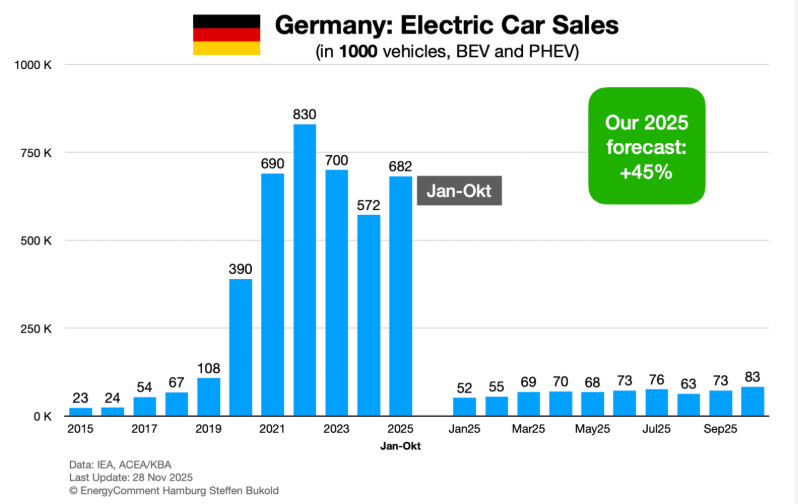
Gemany generally has about 2.8M car sales per year, so they've topped out at roughly 30% being electric. They've picked the low-hanging fruit.
Keep in mind that these to-date numbers are in a policy regime where EV sales have been heavily subsidized. (that includes China BTW)
-
27 minutes ago, chubbs said:
Don't agree. Renewables are manufacturing technologies, like TVs or cellphones, and get cheaper as cumulative production increases. Subsidization was necessary and worthwhile while renewable cost was higher. The cost of the subsidies is minor vs the long-term benefits of sustainable, abundant, cheap and carbon-free energy. China has provided the largest subsidies and is reaping the largest benefits. We should have subsidized more not less.
Renewables have already caught up with fossil fuels in cost and will only get better with time. The transition to renewables is accelerating and will take decades, not centuries. Its inevitable now that renewable costs are lower than fossil fuels.
One thing I often talk about is "low hanging fruit". It depends on the technology, but very often trend bias applies when predicting future growth (the same thing that often happens with stocks, BTW).
Looking at EV sales as example:
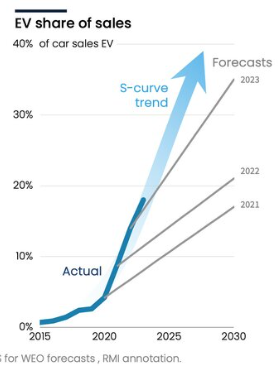
Note that that prediction was made in what appears to be 2022 or 2023.
However here is what has actually happened after that (in the two largest states, which have online dashboards with mandates):
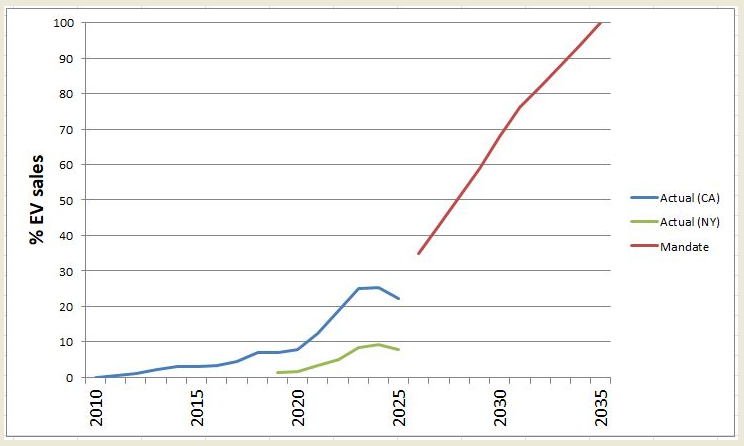
After the low-hanging fruit (rich people with easily-accessible charging at home or work) buying a second car was picked - sales are now falling - not continuing the upwards trend predicted.
Same is true for solar and wind electricity generation. Note where all the larger solar and wind farms are - it's a lot easier to be less expensive when you install them in the easy low-hanging-fruit places to supply local electricity. Not so much when you need to feed the entire grid.
-
 1
1
-
 1
1
-
-
3 hours ago, Brewbeer said:
it's easy for those of us who live several tens or hundreds of feet above sea level to say this sort of stuff, but doing so is denialism with respect to the real flooding that already occurs in Miami neighborhoods (and other sea level locations around the world), flooding that has increased in extent, frequency and intensity over the years, even during fair weather. and let's not forget that Miami is underlain by porous limestone - the ocean will come in underneath any wall that is built. while rich people can afford to move to higher ground and/or hire companies to raise their ground, that isn't affordable for 90% of the people
from the perspective of the person who lives in that house in that neighborhood in the Miami suburbs dealing with increasing frequency and intensity of flooding at their house and neighborhood, my post doesn't seem "alarmist" or "absurdly-hyperbolic" or "ludicrous" at all. It's real. What do they think? How much of their neighborhood needs to be impacted before they consider their property to be affected ? How much of the population / land area of the city needs to be impacted before there is acknowledgement the health of the city is being threatened ? is it 90% ? 75% ? 50% ? And Miami is only one city; there are dozens of low-lying coastal cities across our country and world that are going to see major impacts as coastlines advance
to bring this back to the point of the discussion: how much of Miami needs to be inconvenienced/undesirable/uninhabitable before we acknowledge that the cost of climate change is a factor in the cost of a watt of fossil fuel derived power ?
Wow. Just wow.
I have news for you - I used to live in South Florida, and visited Miami regularly, and I have family that live on the west coast in Florida and still visit there regularly. It's nothing like you characterize. The primary source of flooding we generally saw was due to occasional heavy rains - not some kind of creeping ocean. You're quite the drama queen. You know nothing about the interactions of cities and oceans.
Is there sometimes flooding from hurricanes? Yes there can be (I was there during Andrew). But it's always been the case - it's nothing new, and it's nothing horribly destructive and regular as you present. I'm quite sure that *you* do not and have not lived in such a place.
If it was so bad - why do you think so much construction is going on there? Wouldn't people be moving *away* from there, instead *into* Miami (and Florida overall)? Miami's population has increased over 20% just in the last 20 years. I guess those people must be dolphins or something. I realize the NFL team is the dolphins - but I'm pretty sure the people that live there aren't *actually* dolphins.
-
 1
1
-
-
46 minutes ago, Brewbeer said:
that source is not credible and should not be trusted on this topic
again, it's 10 to 1
we need to be clear about this: at humanity's present fossil fuel burn rate, sea level is going to rise substantially, the science is clear and the scientific community is in agreement. Miami is definitely going under water. We can argue about whether it happens in 2075 or 2125, but those arguments are just semantics; ultimately, the cost is the same, and that cost should be accurately reflected in the price of a watt of fossil fuel energy
Miami being "under water" in 2075 or 2125 is the kind of absurdly-hyperbolic alarmism that I allude to in my other post. Sea levels have risen about 6 inches in a century, and you're proposing that Miami might be "under water" going forward in less than that time? Seriously? Can't you see how ludicrous this is?
And no - the costs aren't the same. Infrastructure generally turns over every few decades or so. Miami as a whole is only 125 years old, and didn't really exist anywhere close to its current form until after WW2 70-80 years ago. Having it be destroyed over the course of say 30-50 years would be *way* more expensive than having it be destroyed over the course of say 300 years, because over the course of 300 years it would essentially be replaced anyhow (without any sea level rise) due to natural aging and replacement. Sea-level-induced replacement (inland and/or higher) would essentially be free.
This discussion assumes, obviously incorrectly, that Miami wouldn't attempt to remediate via sea walls and the like. Even simply raising up the land and building new islands is not that hard - just look at the UAE.
Regarding sources - IMO a research organization presenting a raft of sourced facts and figures is a lot more credible than some random poster on a message board.
-
 1
1
-
-
Stepping back - I would like to say, believe it or not, that I'm not anti-renewable-energy, by any stretch. It will eventually be inevitable and necessary, and will be a good thing in the long run.
I'm being devil's advocate here because I see a big sales job being done - some would say a con job even - in overstating the progress of renewables, and in understating the downside costs of the big renewable push, in terms of the hit it's causing on the prosperity of our society. The migration to renewable is going to take a long time - likely well over a hundred years IMO if not two hundred, and it's going to cause significant and unavoidable pain. We have been in a golden age of easy energy with fossil fuels, and it will end. Fossil is simply easier than renewables, because of physics - primarily energy density; with us living within a few hundred years period reaping the benefits of millions of years of natural storage and compaction of energy into tiny masses of burnable stuff. It will eventually be gone, with us having to transition to renewables. (Short the other alternative which is extinction or at least near-extinction of humans)
In pushing the transition to renewables as hard as we are we are though - before the transition would otherwise happen organically, we are only serving to increase that transition pain. And I'm talking net pain; after any benefit to slowing MMGW (which IMO is negligible) is included in the equation.
-
 1
1
-
-
5 hours ago, Brewbeer said:
it's also worth noting that all the explicit and implicit benefits of the current consumption of energy from fossil fuels are exactly the same as those from the consumption of energy from renewables.
Actually no - they're not Specifically a key benefit to fossil that is not achieved from renewables is baseline reliability. This is of course huge, and a complete deal-breaker when it comes to trying to use renewables for the lion's share of our energy sources, for the foreseeable future.
As it is now renewables can only act as a supplement to the primary energy sources of fossil, nuclear, and to a small extent hydro. Renewables cannot act as a primary source without completely redundant systems (a deal breaker cost-wise) or huge growth in battery storage (also a deal-breaker for the foreseeable future).
Somehow this keeps getting ignored/forgotten about.
It's moving its way towards center stage though, as our electrical grid becomes increasingly unreliable, and our EV sales growth sputters as it has.
The demand growth due to AI certainly isn't helping the situation - it is certainly pushing the issue more to the center of the stage.
Add to that the scale factor. So far renewables have mostly been picking the low-hanging fruit - with power being supplied to the grid in areas where wind and solar are easy - the desert southwest for solar and the flyover country for wind. Trying to scale wind and solar from its current 15% of electrical supply in those regions to the 75-80% or so required nationwide (particularly in the harder-to-reach NE population corridor), and adding the increased demand due to EVs and AI is going to require incredible growth in our electrical grid infrastructure. The benefits-vs-cost equation starts to change dramatically after the low-hanging fruit has been picked.
-
 1
1
-
 1
1
-
 1
1
-
-
1 hour ago, Brewbeer said:
there are about $10 in fossil fuel subsidies spent for every dollar of renewable subsidies when all financial factors including tax breaks are included in the evaluation
Nope. Read the links I posted for actual numbers.
As of 2022 renewable energy comprised 53 percent of all energy subsidies. This includes tax incentives. And this despite renewables only being 21% of production.
The "when all financial factors are included" thing throws a bunch of subjective factors in that allow the author to twist the numbers to meet their agenda (like including "costs" in the equation for fossil fuel but not including the benefits).
-
14 hours ago, wokeupthisam said:
it's worth noting that none of the explicit and implicit benefits of fossil fuel use to societies, not to mention the variances of those among countries with greatly differing economies, are computed in order to arrive at a true estimate of the overall picture. Ignoring that entire side of the market equation is illegitimate.
Bingo.
chubbs and donaldsutherland1 don't seem to understand that "subsidies" and "costs" are not the same thing. You can't just lump them in together like that. If you're going to do that - you also have to include "benefits". Not doing so simply invalidates the argument.
It's an attempt to distract from the actual argument, which is explicit subsidies. That is a valid discussion, and the data clearly shows that renewable energy receives far more subsidies than fossil-fuel energy.
-
 2
2
-
-
5 hours ago, donsutherland1 said:
For perspective, no industry comes close to the explicit and implicit subsidies received by the fossil fuel industry.
From the IMF:
Sorry but that's laughable. They throw throw the whole kitchen sink in and call it "implicit subsidies". Traffic congestion is a fossil fuel subsidy? Why would traffic congestion from an ICE vehicle be any more a subsidy than than for an EV? Can you somehow magically fit EV's into a smaller space or something?
I just bought some groceries at the local supermarket. I'm guessing that somehow fits into their "implied subsidies" bucket.
No - renewable energy is far more subsidized than fossil, by about 30x as much. Lots of data here:
https://www.cato.org/blog/fossil-fuel-subsidies-are-mostly-fiction-real-energy-subsidies-should-go
https://www.eia.gov/analysis/requests/subsidy/pdf/subsidy.pdf

-
 2
2
-
 1
1
-
-
5 hours ago, chubbs said:
The plants that were being shutdown had relatively high cost, that's why they were being shutdown.
Yes and why have their costs been going up? Because of increasingly-onerous environmental regulations, including for CO2 emissions. It is not due to organic costs.
E.g. the EPA in April 2024 implemented new regs requiring coal plants to cut C02 emissions by 90% by 2039 or be shut down. The cost to try to reduce emissions by this much is extremely high, and they know this. They are being forced closed, with "cost" as an excuse to hide the real reason. It's not naturally due to cost.
-
 1
1
-
-
2 hours ago, chubbs said:
Don't agree with your comments. The article provided references. Other than fully depreciated gas and nuclear, Renewables are the lowest cost of electricity in the US. New gas plants, to meet increasing demand, will be much more expensive than fully depreciated; and, as the article states, costs and backlogs for new gas plants are increasing.
I don't disagree with regards to the cost of new builds (though again - they generally don't take into account many factors including regulations, transmission lines, and opportunity cost effect on reliability).
But the title of the article, and your comment, is referring to the cost of electricity, not the cost of new plants. They are not the same thing.
Specifically a big contributor to rising electricity prices is the shutdown of existing operational plants, lowering the supply and thus increasing prices. You seem to keep ignoring/forgetting that. Electricity isn't just created by new-build plants.
-
On 11/26/2025 at 5:42 AM, chubbs said:
Slowing down the introduction of renewables is going to increase US electricity prices.
That article, and your preface, are very misleading.
First of all - that's a prediction, not an observation. We see where many of the alarmists' predictions have gone - many have not come true.
Second - "prices" aren't what's important - costs are. When you take away subsidies for something prices will naturally go up. But that's a good thing, because it means that the actual costs are passed to the end users, where they should be - not hidden in the form of higher taxes and general inflation.
Third - most of the increase predicted there is not due to the slowing down of renewables, but rather due to the shutdown of fossil production, which is pushed by the climate alarmists; and also due to the ramp-up of demand due to AI, which has nothing to do with renewables or fossil, as well as new tariffs.
The article states that the administration "is trying to suppress solar and wind" but presents zero evidence of that.
In general that article is a hugely slanted (anti-fossil) fluff piece.
Had to laugh at this:
"Through 2030, fossil electricity from coal and gas can provide 40-75% of demand growth in the U.S."
The guy apparently doesn't even understand the difference between supply and demand. Coal and gas provide supply, not demand.
-
3 hours ago, chubbs said:
Picking some nits:
- Comparing averages across drivetrains isn't apples-to-apples, because it doesn't account for the mix; instead the comparison needs to be between like-vehicles - e.g. comparison for compact sedans, for mid-size sedans, etc. Also comparison needs to account for quality levels.
- "Lower price" doesn't equate to "out competing". In this case specifically - EV sales in China are only 37% of current sales (per your previous link). So non-EV are still out-competing EV.
- Re-iterating my point about subsidies; "out-competing" also implies level playing field. China, like pretty much every other country, heavily subsidizes their EV's, so it's not a level playing field.
-
12 hours ago, chubbs said:
A number of countries have increasing EV market share with the global share over 20% this year. Link below has EV and plug-in EV market penetration for 61 countries. There's a range between countries with the US and North America a relative low penetration area. Another growing EV market is Heavy-Duty trucks, which are ramping quickly in China (2nd link), reaching a 28% market share there in Aug 25.
https://robbieandrew.github.io/carsales/
https://apnews.com/article/china-truck-lng-ev-diesel-transport-70f3d612de4b45b6f954a7f557f7f741
So basically two where EV sales are "out-competing":
- Norway (super-cheap and easy electric via their natural setting for almost 100% hydro; sales boosted by subsidies)
- Singapore (very wealthy and tiny; less than half the car sales of Iowa; sales boosted by subsidies)
EV sales are certainly making progress (though now stalled in many areas), but I think you're overselling it a bit; especially given the subsidies that have been boosting them (thus my quotes around "out-competing").
As a point of US comparison - here's a chart showing the recent sales slump, and stalling of progress towards the CARB-mandated growth in 13 states, with the two key states of CA and NY shown:
-
59 minutes ago, chubbs said:
"Electric vehicles are out competing combustion vehicles in an increasing number of markets"
What markets?
In the US - California has by far the highest percentage of EV sales of any state - and even there ICE vehicles are outselling EVs by over 3 to 1. And that was before the $7k tax incentive got removed recently.

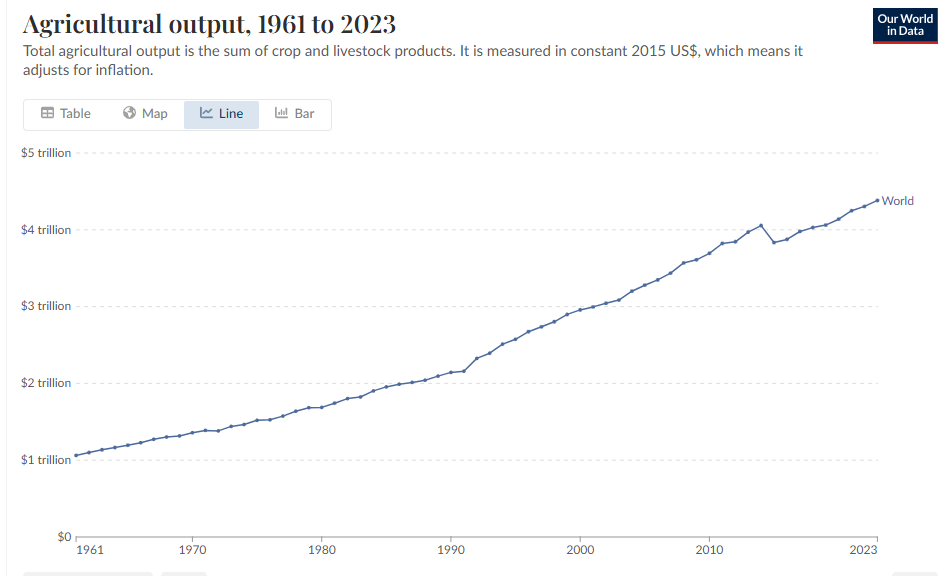
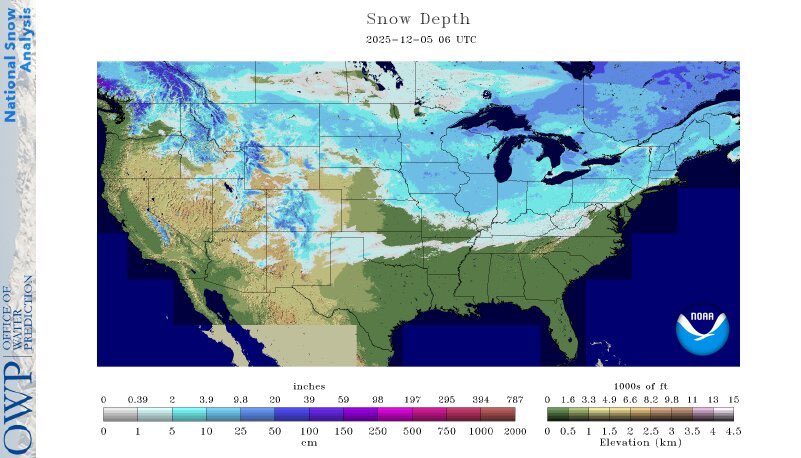
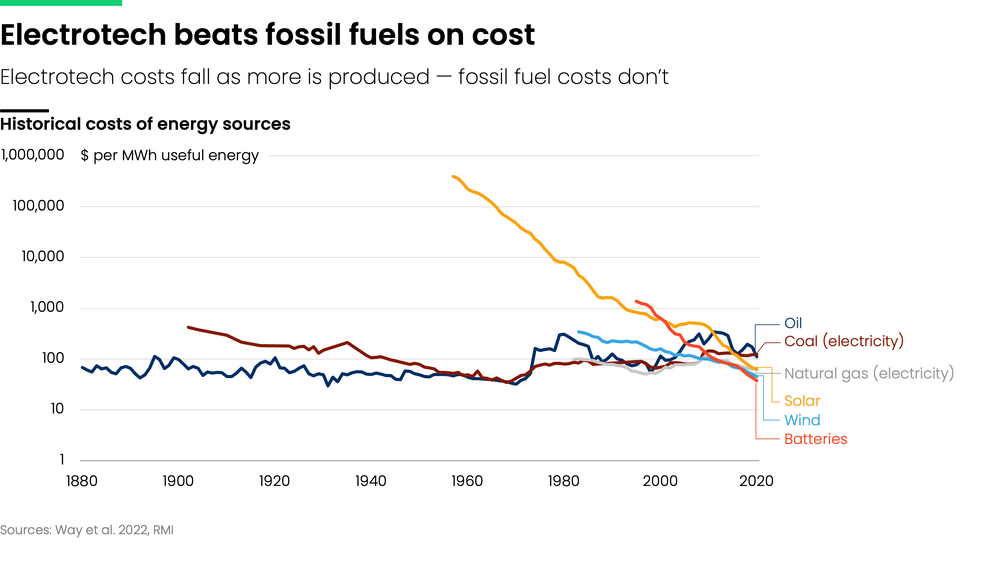
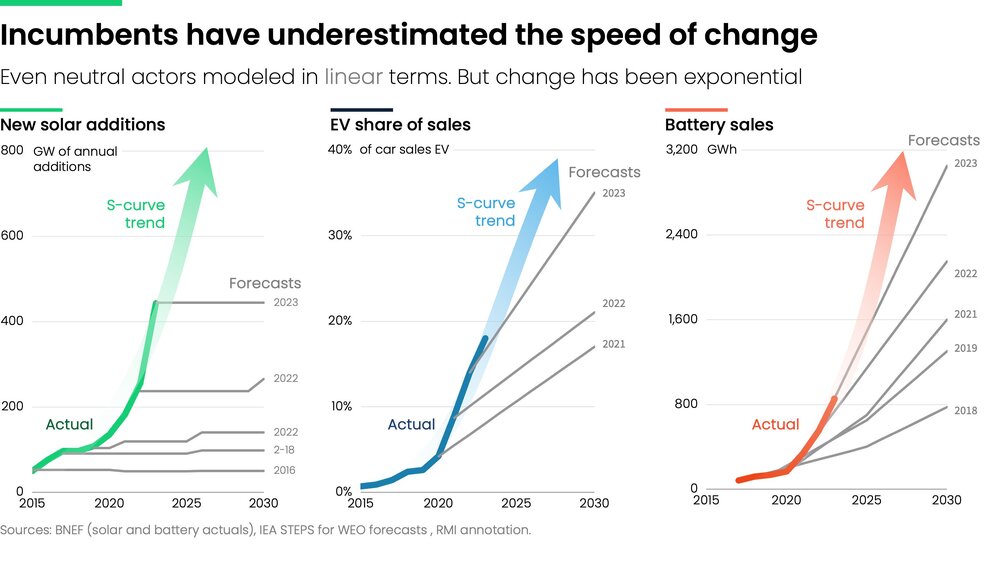
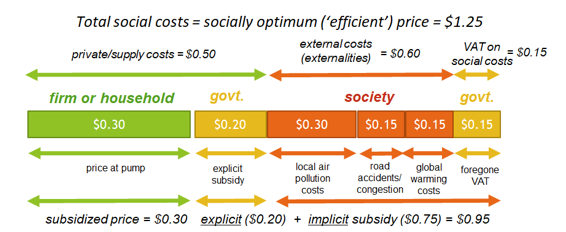


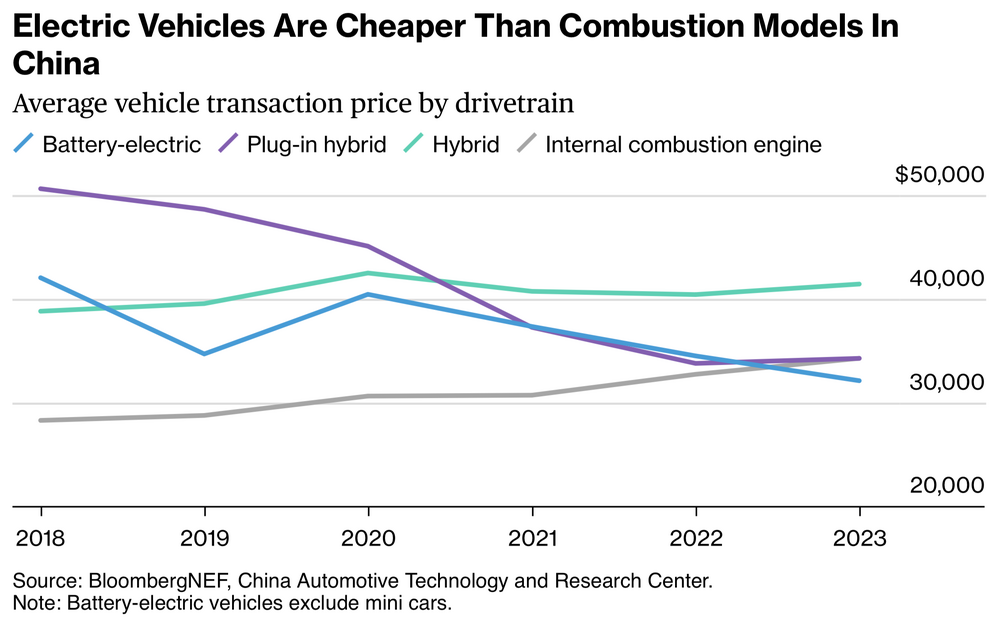
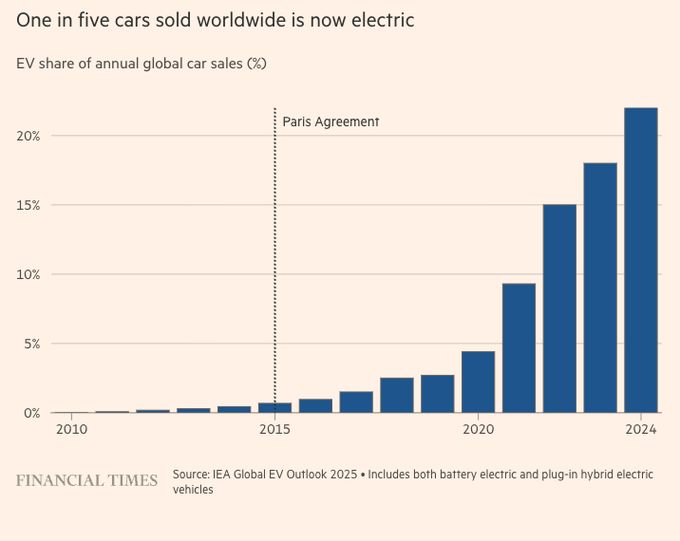
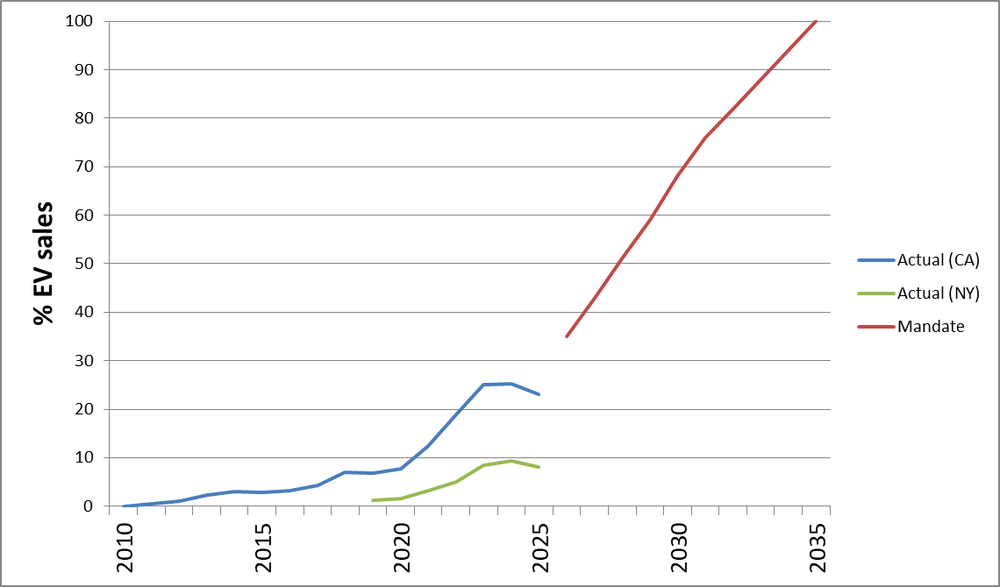
Occasional Thoughts on Climate Change
in Climate Change
Posted
Indeed - as has been the case for all of human history, and will continue to be the case for all of the rest of human history.
The difference is that increasingly the primary reason for people going hungry isn't food production issues (or climate change), it's political instability. (e.g. see https://agecon.unl.edu/violent-conflict-drives-world-hunger-and-food-insecurity/)
If anything attempts to *prevent* climate change will bring about a higher level of food insecurity, as less and less prosperity is available to poor areas, due to increasing pressure to avoid using fossil fuels, e.g. for things like farm equipment, more-abundant electricity to power food processing facilities and transportation, etc.
Tugging on "going hungry" heart strings is nice, but one has to also use one's brain. That includes realization that the use of fossil fuels is a big enabler of prosperity; and that prosperity helps bring about - among other things - an abundance of food.